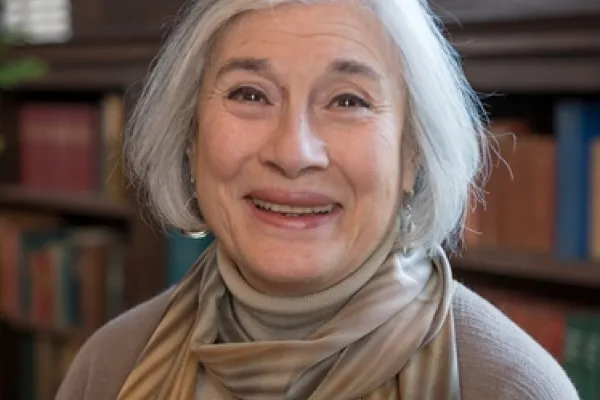A Career in Chemistry That Still Inspires

Published July 12, 2022
“The biggest thing a teacher can hope for is to make an impact on people’s lives,” reflects Lâle Burk, emerita in the chemistry department at Smith College. For nearly five decades, Burk taught hundreds of students—motivating many to seek careers in chemistry—and now she is being honored with an endowed scholarship inspired by her hard work and superb teaching career. The Lâle Aka Burk (’64G) Excellence in Teaching Endowed Scholarship Fund will provide permanent financial assistance for Smith students’ educational experiences.
Donna S. Queeney, a retired higher education administrator who is making the founding gift to the fund, believes that honoring Burk would encourage others to give to the endowed fund. “So many people admire Lâle and I thought this would motivate people to add to the endowment. It’s a little bit that I can do to get the ball rolling, especially with the increasing need for students to have financial aid.”
Queeney’s gift, like dozens of others made in the past year, will be matched by the transformative Here for Every Voice Gift Matching Program. The Here for Every Voice initiative, which aims to raise $200 million for scholarship aid, will equalize the student experience and ensure that students from all backgrounds receive the education they deserve.
A Father’s Dream of Gender Equality
Lâle Burk’s father dreamed of his daughters receiving higher education degrees in the United States. The Turkish family had briefly lived in Flushing, New York, while Burk’s father, an economist, took courses at New York University. As Burk explains, “When I was a child, I heard from my father about gender equality, something Gloria Steinem ’56 would eventually say.”
After graduating from The American College in Istanbul, Burk arrived at Smith College in 1962 to study for her master’s degree in chemistry. Smith had a strong connection with The American College, which had a history of students obtaining their master’s and Ph.D. degrees in the United States. In 1968, Burk received a Ph.D. in chemistry from the Four College Consortium (now the Five College Consortium). While the degree was from the University of Massachusetts Amherst, she did her research at Smith College with the late Sophia Smith Professor of Chemistry Milton Soffer.
Soffer eventually became a colleague and the two continued a long research collaboration in the department. “I was nineteen when I came to Smith. He was a mentor, father figure, role model, as well as my teacher and research advisor,” notes Burk. In 1968, Burk was hired by Smith as a sabbatical replacement and served as a research associate and a postdoctoral fellow. Her gift for teaching did not go unnoticed by the college; by 1972, she was a full-time member of the faculty until her retirement in 2013.
Many students passed through her doors during her decades-long service to the Smith community. “Those were the best years of my life,” Burk reminisces fondly. “Smith students are amazingly dedicated. They were very happy times for me.”
Countless Years in the Classroom
During her time at Smith, Burk watched the organic chemistry class, a prerequisite for medical school, become increasingly popular. She welcomed the growing number of students as an indication of more women pursuing career options, not only in chemistry, but in areas such as healthcare, where women traditionally had not been well represented.
In addition to a course on natural products, she taught a first-year seminar based on essences from nature. “A chemistry of smell, if you will, focusing on plant essential oils and the science behind perfumery,” explains Burk. Perfumery, as it turns out, plays a significant role in the manufacturing of many household products. To wit, one of her former students became a master perfumer at Procter & Gamble. Even fragrance-free products, Burk explains, have additives to disguise undesirable smells. “There is so much chemistry in these fields to teach our students.”
Her dream class, though, which she co-taught with David Dempsey, the now retired associate director for museum services at The Smith College Museum of Art, dealt with the chemistry of artists’ materials. In this course, which met at the museum, students studied a variety of objects from the collection, which included ceramics, metalwork, paintings and works on paper and photographs. The chemistry of the materials used to create art objects determines their longevity; this knowledge is essential to addressing questions of their preservation and conservation. This was a very exciting course for Burk, and also for some of the students who eventually pursued careers in art conservation.
Burk is still in touch with many of her students, including Elizabeth Jamieson, who is now the chair of the chemistry department and director of the Center for Aqueous Biogeochemical Research at Smith College. “I have been very fortunate to know Lâle as both a former student and a colleague. What I appreciate most about her is how incredibly supportive she has been over the years. As a student in her organic chemistry lab, I remember that whenever part of an experiment went wrong, Lâle had a way of helping you see it as a learning experience, not a problem, and you always left her class feeling as though you were a great chemist. She was just as encouraging as a departmental colleague. She has done so much to promote and inspire Smith chemists over the years. This scholarship is a wonderful way to honor all of her efforts,” she says.
Gifts can be made in Lâle Burk’s honor online. Please indicate The Lâle Aka Burk (’64 G) Excellence in Teaching Endowed Scholarship Fund in the Special Instructions tab provided.
By Molly Parr
July 12, 2022
Lâle Burk